e9d786df95c003802604638cf8b3dfeb.ppt
- Количество слайдов: 182

CHAPTER 2 ELECTROSTATICS

ELECTROSTATICS 2. 1 COULUMB’S LAW 2. 2 ELECTRIC FIELD INTENSITY 2. 3 LINE, SURFACE & VOLUME CHARGES 2. 4 ELECTRIC FLUX DENSITY 2. 5 GAUSS’S LAW 2. 6 ELECTRIC POTENTIAL 2. 7 BOUNDARY CONDITIONS 2. 8 CAPACITANCE 2

INTRODUCTION l Electromagnetics is the study of the effect of charges at rest and charges in motion. l Some special cases of electromagnetics: Ø Electrostatics: charges at rest Ø Magnetostatics: charges in steady motion (DC) Ø Electromagnetic waves: waves excited by charges in time-varying motion 3

INTRODUCTION (Cont’d) Fundamental laws of classical electromagnetics Special cases Electrostatics Maxwell’s equations Magnetostatics Statics: Input from other disciplines Electromagnetic waves Geometric Optics Transmission Line Theory Circuit Theory Kirchoff’s Laws 4

INTRODUCTION (Cont’d) l Electrical phenomena caused by friction are part of our everyday lives, and can be understood in terms of electrical charge. l The effects of electrical charge can be observed in the attraction/repulsion of various objects when “charged. ” 5

INTRODUCTION (Cont’d) l Charge comes in two varieties called “positive” and “negative. ” l Objects carrying a net positive charge attract those carrying a net negative charge and repel those carrying a net positive charge. l Objects carrying a net negative charge attract those carrying a net positive charge and repel those carrying a net negative charge. l On an atomic scale, electrons are negatively charged and nuclei are positively charged. 6

INTRODUCTION (Cont’d) l Electric charge is inherently quantized such that the charge on any object is an integer multiple of the smallest unit of charge which is the magnitude of the electron charge e = 1. 602 10 -19 C. l On the macroscopic level, we can assume that charge is “continuous. ” 7

2. 1 COULUMB’S LAW In the late 18 th century, Colonel Charles Augustus Coulomb invented a sensitive torsion balance experimentally that he determine used the to force exerted in one charge by another. 8

COULUMB’S LAW (Cont’d) He found that the force is proportional to the product of two charges, inversely proportional to the square of the distance between the charges and acts in a line containing the two charges. 9

COULUMB’S LAW (Cont’d) The proportional constant, k is: Where the free space permittivity with a value given by: 10

COULUMB’S LAW (Cont’d) Charge Q 1 exerts a vector force F 12 in Newton's (N) on charge Q 2, 11

COULUMB’S LAW (Cont’d) If more than two charges, use the principle of superposition to determine the force on a particular charge. If there are N charges, Q 1, Q 2. . . QN located respectively at point with position vectors r 1, r 2. . . r. N the resultant force F on a charge Q located at point r is the vector sum of the forces exerted on Q by each charges Q 1, Q 2. . . QN 12

COULUMB’S LAW (Cont’d) Or generally, 13

COULUMB’S LAW (Cont’d) For example, 14

EXAMPLE 1 Suppose 10 n. C charge Q 1 located at (0. 0, 4. 0 m) and a 2. 0 n. C charge Q 2 located at (0. 0, 4. 0 m, 0. 0). Find the force acting on Q 2 from Q 1. 15

SOLUTION TO EXAMPLE 1 To employ Coulomb’s Law, first find vector Magnitude of 16

SOLUTION TO EXAMPLE 1 (Cont’d) And Then 17

2. 2 ELECTRIC FIELD INTENSITY If Q 1 is fixed to be at origin, a second charge Q 2 will have force acting on Q 1 and can be calculated using Coulomb’s Law. We also could calculate the force vector that would act on Q 2 at every point in space to generate a field of such predicted force values. 18

ELECTRIC FIELD INTENSITY (Cont’d) It becomes convenient to define electric field intensity E 1 or force per unit charge as: This field from charge Q 1 fixed at origin results from the force vector F 12 for any arbitrarily chosen value of Q 2 19

ELECTRIC FIELD INTENSITY (Cont’d) Coulomb’s law can be rewritten as to find the electric field intensity at any point in space resulting from a fixed charge Q. 20

EXAMPLE 2 Let a point charge Q 1 = 25 n. C be located at P 1 (4, -2, 7). If ε = ε 0, find electric field intensity at P 2 (1, 2, 3). 21

SOLUTION TO EXAMPLE 2 By using the electric field intensity, This field will be: 22

SOLUTION TO EXAMPLE 2 (Cont’d) Where, and 23

ELECTRIC FIELD INTENSITY (Cont’d) If there N are respectively at charges, point with Q 1, Q 2. . . QN located position vectors r 1, r 2. . . r. N the electric field intensity at point r is: 24

FIELD LINES The behavior of the fields can be visualized using field lines: Field vectors plotted within a regular grid in 2 D space surrounding a point charge. 25

FIELD LINES (Cont’d) Some of these field vectors can easily be joined by field lines that emanate from the positive point charge. The direction of the arrow indicates the direction of electric fields The magnitude is given by density of the lines 26

FIELD LINES (Cont’d) The field lines terminated at a negative point charge The field lines for a pair of opposite charges 27

2. 3 LINE, SURFACE & VOLUME CHARGES Electric fields due to continuous charge distributions: 28

LINE, SURFACE & VOLUME CHARGES (Cont’d) To determine the charge for each distributions: Line charge: Surface charge: Volume charge: 29

LINE CHARGE Infinite Length of Line Charge: To derive the electric field intensity at any point in space resulting from an infinite length line of charge placed conveniently along the z-axis 30

LINE CHARGE (Cont’d) Place an amount of charge in coulombs along the z axis. The linear charge density is coulombs of charge per meter length, Choose an arbitrary point P where we want to find the electric field intensity. 31

LINE CHARGE (Cont’d) The electric field intensity is: But, the field is only vary with the radial distance from the line. There is no segment of charge d. Q anywhere on the z-axis that will give us. So, 32

LINE CHARGE (Cont’d) Consider a d. Q segment a distance z above radial axis, which will add the field components for the second charge element d. Q. The components cancel each other (by symmetry) , and the adds, will give: 33

LINE CHARGE (Cont’d) Recall for point charge, For continuous charge distribution, the summation of vector field for each charges becomes an integral, 34

LINE CHARGE (Cont’d) The differential charge, The vector from source to test point P, 35

LINE CHARGE (Cont’d) Which has magnitude, and a unit vector, So, the equation for integral of continuous charge distribution becomes: 36

LINE CHARGE (Cont’d) Since there is no component, 37

LINE CHARGE (Cont’d) Hence, the electric field intensity at any point ρ away from an infinite length is: For any finite length, use the limits on the integral. 38

EXAMPLE 3 Use Coulomb’s Law to find electric field intensity at (0, 0, h) for the ring of charge, of charge density, centered at the origin in the x-y plane. 39

SOLUTION TO EXAMPLE 3 By inspection, the ring charges delivers only and contribution to the field. component will be cancelled by symmetry. 40

SOLUTION TO EXAMPLE 3 (Cont’d) Each term need to be determined: The differential charge, 41

SOLUTION TO EXAMPLE 3 (Cont’d) The vector from source to test point, Which has magnitude, and a unit vector, 42

SOLUTION TO EXAMPLE 3 (Cont’d) The integral of continuous charge distribution becomes: 43

SOLUTION TO EXAMPLE 3 (Cont’d) Rearranging, Easily solved, 44

EXAMPLE 4 An infinite length line of charge exists at x = 2 m and z = 4 m. Find the electric field intensity at the origin. 45

SOLUTION TO EXAMPLE 4 Sketch in three dimensions and the cross section: 46

SOLUTION TO EXAMPLE 4 (Cont’d) The vector from line charge to the origin: Which has magnitude, and a unit vector, 47

SOLUTION TO EXAMPLE 4 (Cont’d) Inserting into the infinite line charge equation: 48

SURFACE CHARGE Infinite Sheet of Surface Charge: To derive the electric field intensity at point P at a height h above a charge sheet of infinite area (x-y plane). The charge distribution, is in 49

SURFACE CHARGE (Cont’d) 50

SURFACE CHARGE (Cont’d) Consider a differential charge, The vector from surface charge to the origin: 51

SURFACE CHARGE (Cont’d) Which has magnitude, and a unit vector, Where, for continuous charge distribution: 52

SURFACE CHARGE (Cont’d) The equation becomes: Since only z components exists, 53

SURFACE CHARGE (Cont’d) 54

SURFACE CHARGE (Cont’d) A general expression for the field from a sheet charge is: Where is the unit vector normal from the sheet to the test point. 55

EXAMPLE 5 An infinite extent sheet of charge exists at the plane y = -2 m. Find the electric field intensity at point P (0, 2 m, 1 m). 56

SOLUTION TO EXAMPLE 5 Sketch the figure: 57

SOLUTION TO EXAMPLE 5 (Cont’d) The unit vector directed away from the sheet and toward the point P is 58

VOLUME CHARGE A volume charge is distributed over a volume and is characterized by its volume charge density, in The total charge in a volume containing a charge distribution, is found by integrating over the volume: 59

EXAMPLE 6 Find the total charge over the volume with volume charge density, 60

SOLUTION TO EXAMPLE 6 The total charge, with volume: Thus, 61

VOLUME CHARGE (Cont’d) To find the electric field intensity resulting from a volume charge, we use: Since the vector R and will vary over the volume, this triple integral can be difficult. It can be much simpler to determine E using Gauss’s Law. 62

2. 4 ELECTRIC FLUX DENSITY Consider an amount of charge +Q is applied to a metallic sphere of radius a. Enclosed this charged sphere using a pair of connecting hemispheres with bigger radius. 63

ELECTRIC FLUX DENSITY (Cont’d) The outer shell is grounded. Remove the ground then we could find that –Q of charge has accumulated on the outer sphere, meaning the +Q charge of the inner sphere has induced the –Q charge on the outer sphere. 64

ELECTRIC FLUX DENSITY (Cont’d) Electric flux, extends from the positive charge and casts about for a negative charge. It begins at the +Q charge and terminates at the –Q charge. The electric flux density, D in is: where 65

ELECTRIC FLUX DENSITY (Cont’d) This is the relation between D and E, where is the material permittivity. The advantage of using electric flux density rather than using electric field intensity is that the number of flux lines emanating from one set of charge and terminating on the other, independent from the media. We can find the total flux over a surface as: 66

ELECTRIC FLUX DENSITY (Cont’d) We could also find the electric flux density, D for: Ø Infinite line of charge: Where So, 67

ELECTRIC FLUX DENSITY (Cont’d) Ø Infinite sheet of charge: Where So, Ø Volume charge distribution: So, 68

EXAMPLE 7 Find the amount of electric flux through the surface at z = 0 with and 69

SOLUTION TO EXAMPLE 7 The differential surface vector is We could have chosen but the positive differential surface vector is pointing in the same direction as the flux, which give us a positive answer. 70

SOLUTION TO EXAMPLE 7 (Cont’d) Therefore, Why? ! 71

EXAMPLE 8 Determine D at (4, 0, 3) if there is a point charge at (4, 0, 0) and a line charge along the y axis. 72

SOLUTION TO EXAMPLE 8 How to visualize ? ! 73

SOLUTION TO EXAMPLE 8 (Cont’d) Let total flux, Where DQ is flux densities due to point charge and DL is flux densities due to line charge. Thus, 74

SOLUTION TO EXAMPLE 8 (Cont’d) Where, Which has magnitude, and a unit vector, 75

SOLUTION TO EXAMPLE 8 (Cont’d) So, 76

SOLUTION TO EXAMPLE 8 (Cont’d) And Where, So, 77

SOLUTION TO EXAMPLE 8 (Cont’d) Therefore, total flux: 78

2. 5 GAUSS’S LAW If a charge is enclosed, the net flux passing through the enclosing surface must be equal to the charge enclosed, Qenc. Gauss’s Law states that: The net electric flux through any closed surface is equal to the total charge enclosed by that surface 79

GAUSS’S LAW (Cont’d) It can be rearranged so that we have relation between the Gauss’s Law and the electric flux. 80

GAUSS’S LAW (Cont’d) Gauss’s Law is useful in finding the fields for problems that have high degree of symmetry. • Determine variables influence D and what components D present • Select an enclosing surface, called Gaussian Surface, whose differential surface is directed outward from the enclosed volume and is everywhere (either tangent or normal to D) 81

GAUSS’S LAW APPLICATION (Cont’d) Use Gauss’s Law to determine electric field intensity for each cases below: Ø Point Charge Ø Infinite length of Line Charge Ø Infinite extent Sheet of Charge 82

POINT CHARGE • Point Charge: It has spherical coordinate symmetry, where the field is everywhere directed radially away from the origin. Thus, 83

POINT CHARGE (Cont’d) For a gaussian surface, we could find the differential surface vector is: So, 84

POINT CHARGE (Cont’d) Since the gaussian surface has a fixed radius, Dr will be constant and can be taken from integration to yield 85

POINT CHARGE (Cont’d) By using Gauss’s Law, where: So, which leads to expected result: See page 16! 86

INFINITE LENGTH LINE OF CHARGE • Infinite length line of charge: Find D and then E at any point A Gaussian surface containing the point P is placed around a section of an infinite length line of charge density L occupying the z-axis. 87

LINE CHARGE (Cont’d) An element of charge d. Q along the line will give Dρ and Dz. But second element of d. Q will result in cancellation of Dz. Thus, The flux through the closed surface is: 88

LINE CHARGE (Cont’d) Where, Then, we know that Dρ is constant on the side of gaussian surface 89

LINE CHARGE (Cont’d) The charge enclosed by the gaussian surface: We know that, So, Thus, as expected: 90

INFINITE EXTENT SHEET OF CHARGE • Infinite extent sheet of charge: Determine the field everywhere resulting from an infinite extent sheet of charge ρS placed on the x-y plane at z = 0. Locate a point at which we want to find the field along the z axis at height h. 91

SHEET OF CHARGE (Cont’d) Gaussian surface must contain this point and surround some portion of the charged sheet. A rectangular box is employed as the Gaussian surface surrounding a section of sheet charge with sides 2 x, 2 y and 2 z 92

SHEET OF CHARGE (Cont’d) Only a DZ component will be present, and the charge enclosed is simply: No flux through the side of the box, so find the flux through the top and bottom surface 93

SHEET OF CHARGE (Cont’d) Notice that the answer is independent of the height of the box. 94

SHEET OF CHARGE (Cont’d) Then we have: or And electric field intensity, as expected: 95

GAUSS’S LAW (Cont’d) Related to Gauss’s Law, where net flux is evaluated exiting a closed surface, is the concept of divergence. Expression for divergence by applying Gauss’s Law might be too lengthy to derive, but it can be described as: 96

GAUSS’S LAW (Cont’d) The expression is also called the point form of Gauss’s Law, since it occurs at some particular point in space. For instance, Plunger stationary – no net movement of molecules Plunger moves up – net movement where air molecules diverging air is expanding Plunger pushes in – net flux is negative and molecules diverging air is compressing 97

EXAMPLE 9 Suppose: Find the flux through the surface of a cylinder with and by evaluating the left side and the right side of the divergence theorem. 98

SOLUTION TO EXAMPLE 9 Remember the divergence theorem? We can first evaluate the left side of the divergence theorem by considering: 99

SOLUTION TO EXAMPLE 9 (Cont’d) A sketch of this cylinder is shown with differential vectors. The integrals over the top and bottom surfaces are each zero, since: 100
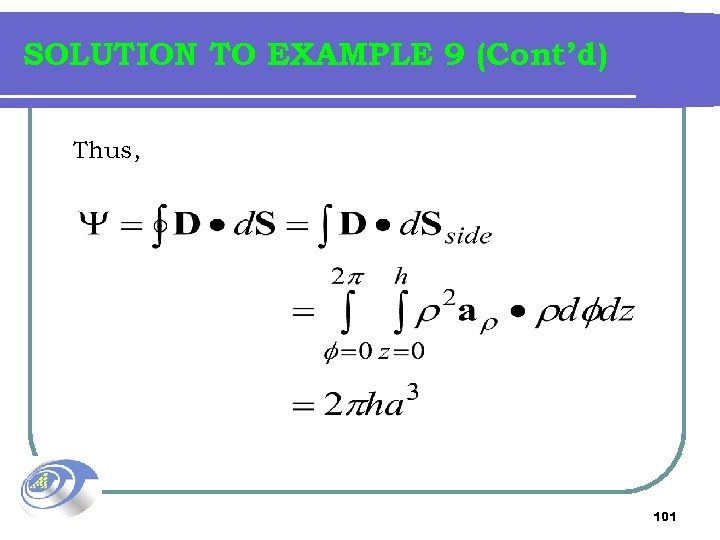
SOLUTION TO EXAMPLE 9 (Cont’d) Thus, 101

SOLUTION TO EXAMPLE 9 (Cont’d) For evaluation of the right side of the divergence theorem, first find the divergence in cylindrical coordinate: 102

SOLUTION TO EXAMPLE 9 (Cont’d) Performing a volume integration on this divergence, This is the same! 103

2. 6 ELECTRIC POTENTIAL To develop the concept of electric potential and show its relationship to electric field intensity. In moving the object from point a to b, the work can be expressed by: d. L is differential length vector along some portion of the path between a and b 104

ELECTRIC POTENTIAL (Cont’d) The work done by the field in moving the charge from a to b is If an external force moves the charge against the field, the work done is negative: 105

ELECTRIC POTENTIAL (Cont’d) We can defined the electric potential difference, Vba as the work done by an external source to move a charge from point a to point b as: Where, 106

ELECTRIC POTENTIAL (Cont’d) Consider the potential difference between two points in space resulting from the field of a point charge located at origin, where the electric field intensity is radially directed, then move from point a to b to have: 107

ELECTRIC POTENTIAL (Cont’d) Thus, The absolute potential at some finite radius from a point charge fixed at the origin: 108

ELECTRIC POTENTIAL (Cont’d) If the collection of charges becomes a continuous distribution, we could find: Where, Line charge Surface charge Volume charge 109

ELECTRIC POTENTIAL (Cont’d) The principle of superposition, where applied to electric field also applies to potential difference. Or generally, 110
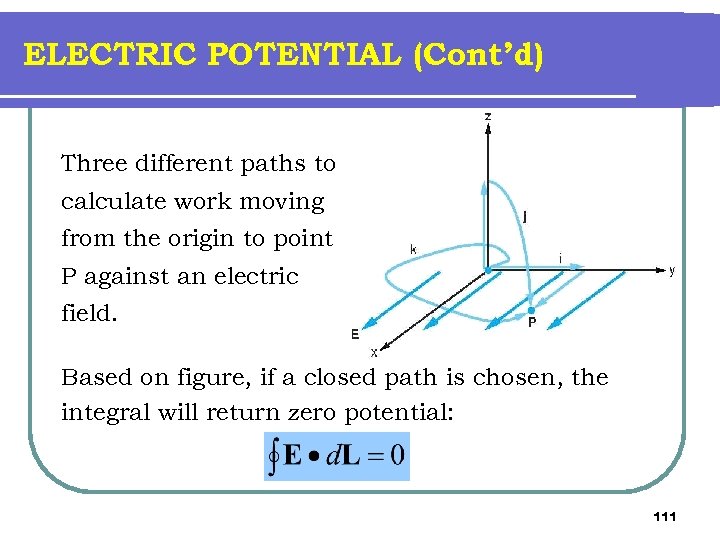
ELECTRIC POTENTIAL (Cont’d) Three different paths to calculate work moving from the origin to point P against an electric field. Based on figure, if a closed path is chosen, the integral will return zero potential: 111

EXAMPLE 10 Two point charges -4 μC and 5 μC are located at (2, 1 -, 3) and (0, 4, -2) respectively. Find the potential at (1, 0, 1). 112

SOLUTION TO EXAMPLE 10 Let and So, Where, 113

SOLUTION TO EXAMPLE 10 (Cont’d) Therefore, 114

ELECTRIC POTENTIAL (Cont’d) The electrostatic potential contours from a point charge form equipotential surfaces surrounding the point charge. The surfaces are always orthogonal to the field lines. The electric field can be determined by finding the max. rate and direction of spatial change of the potential field. 115

ELECTRIC POTENTIAL (Cont’d) Therefore, The negative sign indicates that the field is pointing in the direction of decreasing potential. By applying to the potential field: 116
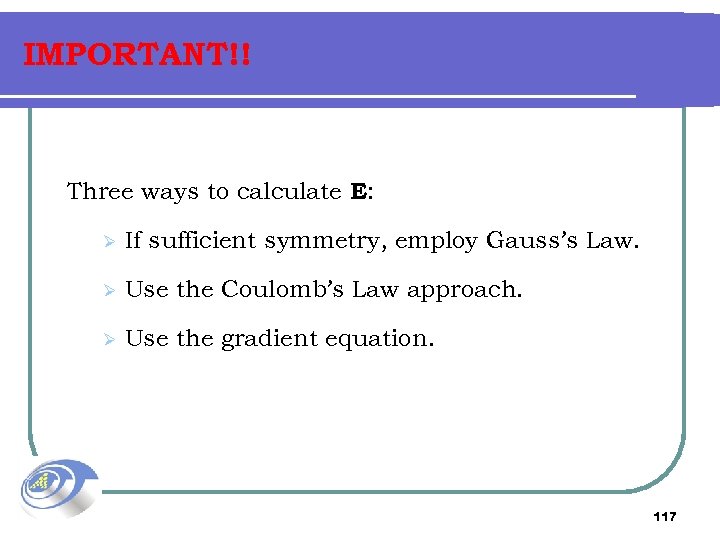
IMPORTANT!! Three ways to calculate E: Ø If sufficient symmetry, employ Gauss’s Law. Ø Use the Coulomb’s Law approach. Ø Use the gradient equation. 117

EXAMPLE 11 Consider a disk of charge ρS, find the potential at point (0, 0, h) on the z-axis and then find E at that point. 118

SOLUTION TO EXAMPLE 11 Find that, and With then, 119

SOLUTION TO EXAMPLE 11 (Cont’d) How to calculate the integral? Let integral and leads to then, 120

SOLUTION TO EXAMPLE 11 (Cont’d) To find E, need to know how V is changing with position. In this case E varies along the z-axis, so simply replace h with z in the answer for V, then proceed with the gradient equation. 121

2. 7 BOUNDARY CONDITIONS So far we have considered the existence of electric field in a region consisting of two different media, the condition that the field must satisfy at the interfacing separating the media called “boundary condition”. Thus, we could see how the fields behave at the boundary between a pair of dielectrics or between a dielectric and a conductor. 122

BOUNDARY CONDITIONS (Cont’d) First boundary condition can be determined by performing a line integral of E around a closed rectangular path, 123

BOUNDARY CONDITIONS (Cont’d) Fields are shown in each medium along with normal and tangential components. For static fields, Integrate in the loop clockwise starting from a, 124

BOUNDARY CONDITIONS (Cont’d) Evaluate each segment, 125

BOUNDARY CONDITIONS (Cont’d) Summing for each segment, then we have the first boundary condition: 126

BOUNDARY CONDITIONS (Cont’d) Second boundary condition can be determined by applying Gauss’s Law over a small pillbox shaped Gaussian surface, 127

BOUNDARY CONDITIONS (Cont’d) The Gauss’s Law, Where, The pillbox is short enough, so the flux passes through the side is negligible. 128

BOUNDARY CONDITIONS (Cont’d) So, only top and bottom where: Which sums to: 129

BOUNDARY CONDITIONS (Cont’d) And the right side of Gauss’s Law, Thus, it leads to the second boundary condition: This is when the normal direction from medium 2 to medium 1. 130
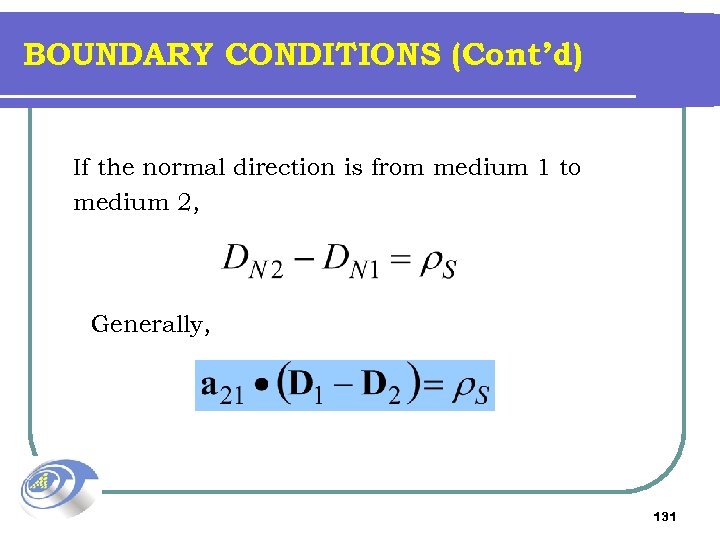
BOUNDARY CONDITIONS (Cont’d) If the normal direction is from medium 1 to medium 2, Generally, 131

BOUNDARY CONDITIONS (Cont’d) For a boundary conditions between a dielectric and a good conductor, Because in a good conductor, E = 0. And since the electric flux density is zero inside the conductor, 132

EXAMPLE 12 Consider that the field E 1 is known as: Find the field E 2 in the other dielectrics. 133

SOLUTION TO EXAMPLE 12 134

BOUNDARY CONDITIONS (Cont’d) We can employ Poisson’s and Laplace’s equations to help find the potential function when conditions at the boundaries are specified. From divergence theorem expression, By considering , 135

BOUNDARY CONDITIONS (Cont’d) From the gradient expression, Which gives us Poisson’s equation, In charge free medium in which becomes Laplace’s equation: , it 136
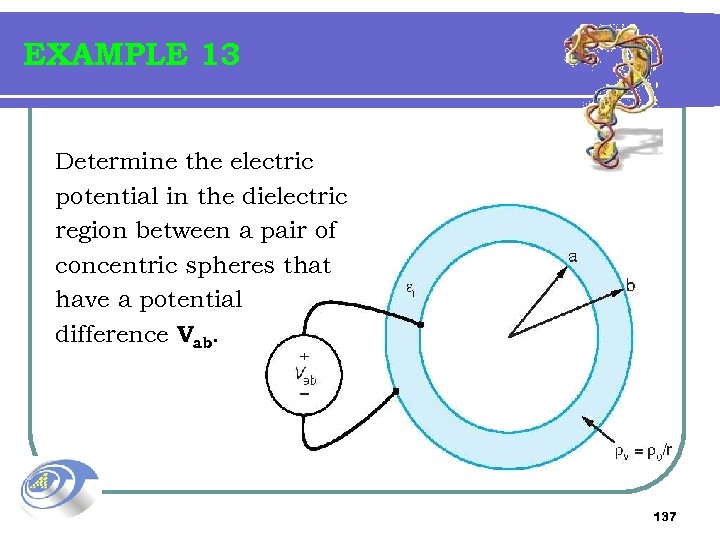
EXAMPLE 13 Determine the electric potential in the dielectric region between a pair of concentric spheres that have a potential difference Vab. 137

SOLUTION TO EXAMPLE 13 The charge distribution is: This employs Poisson’s equation and the potential is only a function of r, 138

SOLUTION TO EXAMPLE 13 (Cont’d) Multiply with r 2 and integrate to obtain, Dividing both sides with r 2 and integrate again, 139

SOLUTION TO EXAMPLE 13 (Cont’d) Assume that the Vab consists of a voltage Va on the inner conductor and the outer conductor is grounded. So, 140

SOLUTION TO EXAMPLE 13 (Cont’d) (3) From (3) you can get: Thus, 141

SOLUTION TO EXAMPLE 13 (Cont’d) Then, the potential between the spheres is given by: 142

2. 8 CAPACITANCE The amount of charge that accumulates as a function of potential difference is called the capacitance. The unit is the farad (F) or coulomb per volt. 143

CAPACITANCE (Cont’d) Two methods for determining capacitance: Ø Q Method Assume a charge +Q on plate a and a charge –Q on plate b. • Solve for E using the appropriate method (Coulomb’s Law, Gauss’s Law, boundary conditions) • Solve for the potential difference Vab between the plates (The assumed Q will divide out) • 144

CAPACITANCE (Cont’d) Ø V Method • Assume Vab between the plates. • Find E , then D using Laplace’s equation. Find ρS, and then Q at each plate using conductor dielectric boundary condition (DN = ρS ) • • C = Q/Vab (the assumed Vab will divide out) 145

EXAMPLE 14 Use Q method to find the capacitance for the parallel plate capacitor as shown. 146

SOLUTION TO EXAMPLE 14 Place charge +Q on the inner surface of the top plate, and –Q charge on the upper surface of the bottom plate, where the charge density, from Use conductor dielectric boundary, to obtain: from 147

SOLUTION TO EXAMPLE 14 (Cont’d) We could find the electric field intensity, E The potential difference across the plates is: 148

SOLUTION TO EXAMPLE 14 (Cont’d) Finally, to get the capacitance: 149

EXAMPLE 15 Use V method to find the capacitance for a length L of coaxial line of inner conductor radius a and outer radius b, filled with dielectric permittivity as shown. 150

SOLUTION TO EXAMPLE 15 Employ Laplace’s equation to find the potential field everywhere in the dielectric. Assume that fringing fields are neglected and the field is only in function of ρ. Laplace’s equation becomes: 151

SOLUTION TO EXAMPLE 15 (Cont’d) Integrating twice to obtain: Apply boundary condition to determine A and B. Let V(b) = 0 and V(a) = Vab to get: So, 152

SOLUTION TO EXAMPLE 15 (Cont’d) Apply the gradient to obtain E: and also. . 153

SOLUTION TO EXAMPLE 15 (Cont’d) At inner conductor, the flux is directed outward indicating a positive surface charge density, We can find Q on the inner conductor with: 154
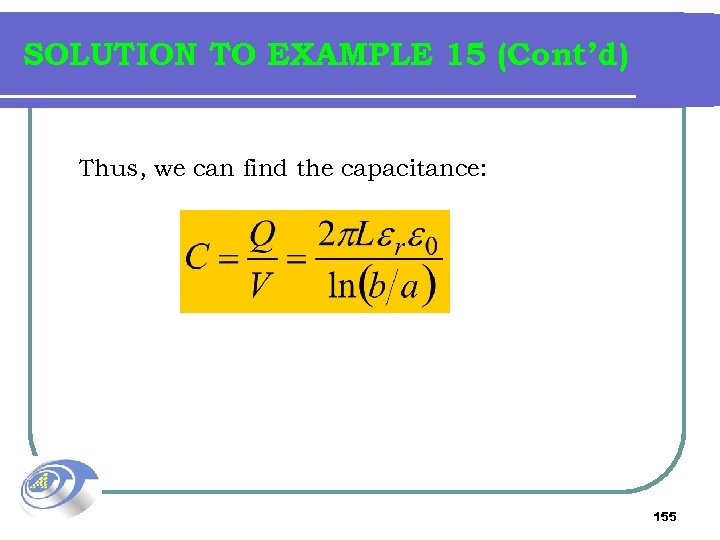
SOLUTION TO EXAMPLE 15 (Cont’d) Thus, we can find the capacitance: 155

EXAMPLE 16 Conducting spherical shells with radius a =10 cm and b = 30 cm are maintained at a potential difference of 100 V, such that V(r = a) = 100 V and V(r = b) = 0 V. Determine: • The V and E in the region between the shells. • If εr = 2. 5 in the shells, determine the total charges induced on the shells and the capacitance of the capacitor. 156

EXAMPLE 16 (Cont’d) With: 157

SOLUTION TO EXAMPLE 16 Employ Laplace’s equation to find the potential field and the field is only in function of r. Laplace’s equation becomes: Multiply by r 2, 158

SOLUTION TO EXAMPLE 16 (Cont’d) Integrating once gives Integrating again gives 159

SOLUTION TO EXAMPLE 16 (Cont’d) To obtain the value of constant A and B, use boundary conditions, where: When, Thus, 160

SOLUTION TO EXAMPLE 16 (Cont’d) When, 161

SOLUTION TO EXAMPLE 16 (Cont’d) Therefore, the potential difference V 162

SOLUTION TO EXAMPLE 16 (Cont’d) Apply the gradient to obtain E: So, the electric field intensity E 163

SOLUTION TO EXAMPLE 16 (Cont’d) The total charges Q is: 164

SOLUTION TO EXAMPLE 16 (Cont’d) This yields to: 165

SOLUTION TO EXAMPLE 16 (Cont’d) Thus, substituting the values of a, b and V 0 to get the total charges, Q 166

SOLUTION TO EXAMPLE 16 (Cont’d) And for the potential difference V = V 0. So, the capacitance, C 167

CHAPTER 2 END

PRACTICAL APPLICATION Ø Laser Printer Ø Electret Microphone Ø Electrolytic Capacitors 169

LASER PRINTER 170

LASER PRINTER (Cont’d) • OPC drum : Organic Photoconductive Cartridge – has a special coating will hold electrostatic charge. • The surface is photoconductive – will discharge if surface hit by light. i. A portion of drum passes under a negative charged wire large negative charges induces a positive charge on the drum. ii. Image to be printed is delivered to this charged region by laser and spinning mirror combination. iii. Wherever the laser light strikes the drum, the photoconductive material is discharged. 171
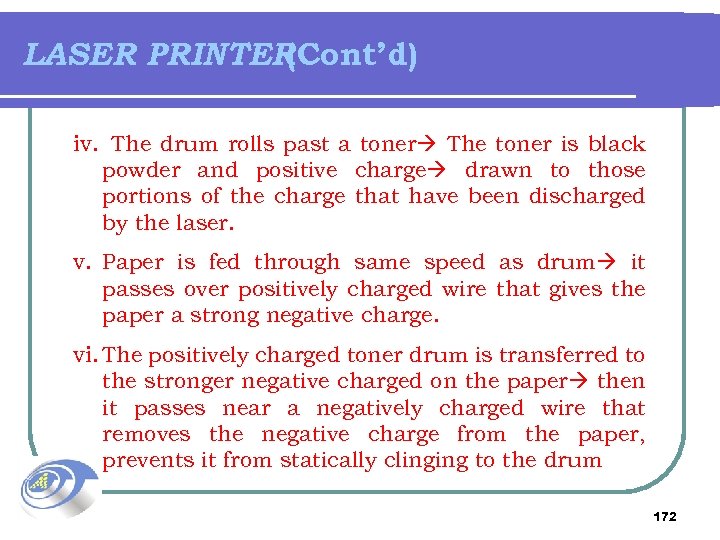
LASER PRINTER (Cont’d) iv. The drum rolls past a toner The toner is black powder and positive charge drawn to those portions of the charge that have been discharged by the laser. v. Paper is fed through same speed as drum it passes over positively charged wire that gives the paper a strong negative charge. vi. The positively charged toner drum is transferred to the stronger negative charged on the paper then it passes near a negatively charged wire that removes the negative charge from the paper, prevents it from statically clinging to the drum 172

LASER PRINTER (Cont’d) vii. The paper and loose toner powder passed through heated fuser rollers powder melts into the paper fiber the warm paper exits the printer. • The drum continues rolling, passing through high intensity light discharges all the photoconductors to erase the image from the drum, and ready for application of positive charge again from corona wire. 173

SUMMARY (1) • The force exerted on a charge Q 1 on charge Q 2 in a medium of permittivity ε is given by Coulomb’s Law: Where is a vector from charge Q 1 to Q 2 • Electric field intensity E 1 is related to force F 12 by: 174

SUMMARY (2) The Coulomb’s Law can be rewritten as: For a continuous charge distribution: • For a point charge at origin: 175

SUMMARY (3) • For an infinite length line charge ρL on the z axis • For an infinite extent sheet of charge ρS • Electric flux density related to field intensity by: Where εr is the relative permittivity in a linear, isotropic and homogeneous material. 176

SUMMARY (4) • Electric flux passing through a surface is given by: • Gauss’s Law states that the net electric flux through any closed surface is equal to the total charge enclosed by that surface: Point form of Gauss’s Law is 177

SUMMARY (5) • The electric potential difference Vab between a pair of points a and b in an electric field is given by: Where Va and Vb are the electrostatics potentials at a and b respectively. For a distribution of charge in the vicinity of the origin, where a zero reference voltage is taken at infinite radius: 178

SUMMARY (6) • E is related to V by the gradient equation: Which for Cartesian coordinates is: • The conditions for the fields at the boundary between a pair of dielectrics is given by: and 179

SUMMARY (7) Where ET 1 and ET 2 are the electric field components tangential to the boundary, a 21 is a unit vector from medium 2 to 1 and ρS is the surface charge at the boundary. If no surface charge is present, the components of D normal to the boundary are equal: At the boundary between a conductor and a dielectric, the conditions are: and 180

SUMMARY (8) • Poisson’s equation is: Where the Laplacian of V in Cartesian coordinates is given by: In a charge free medium, Poisson’s equation reduces to Laplace’s equation 181

SUMMARY (9) • Capacitance is a measure of charge storage capability and is given by: For coaxial cable: So, For two concentric spheres: So, 182
e9d786df95c003802604638cf8b3dfeb.ppt